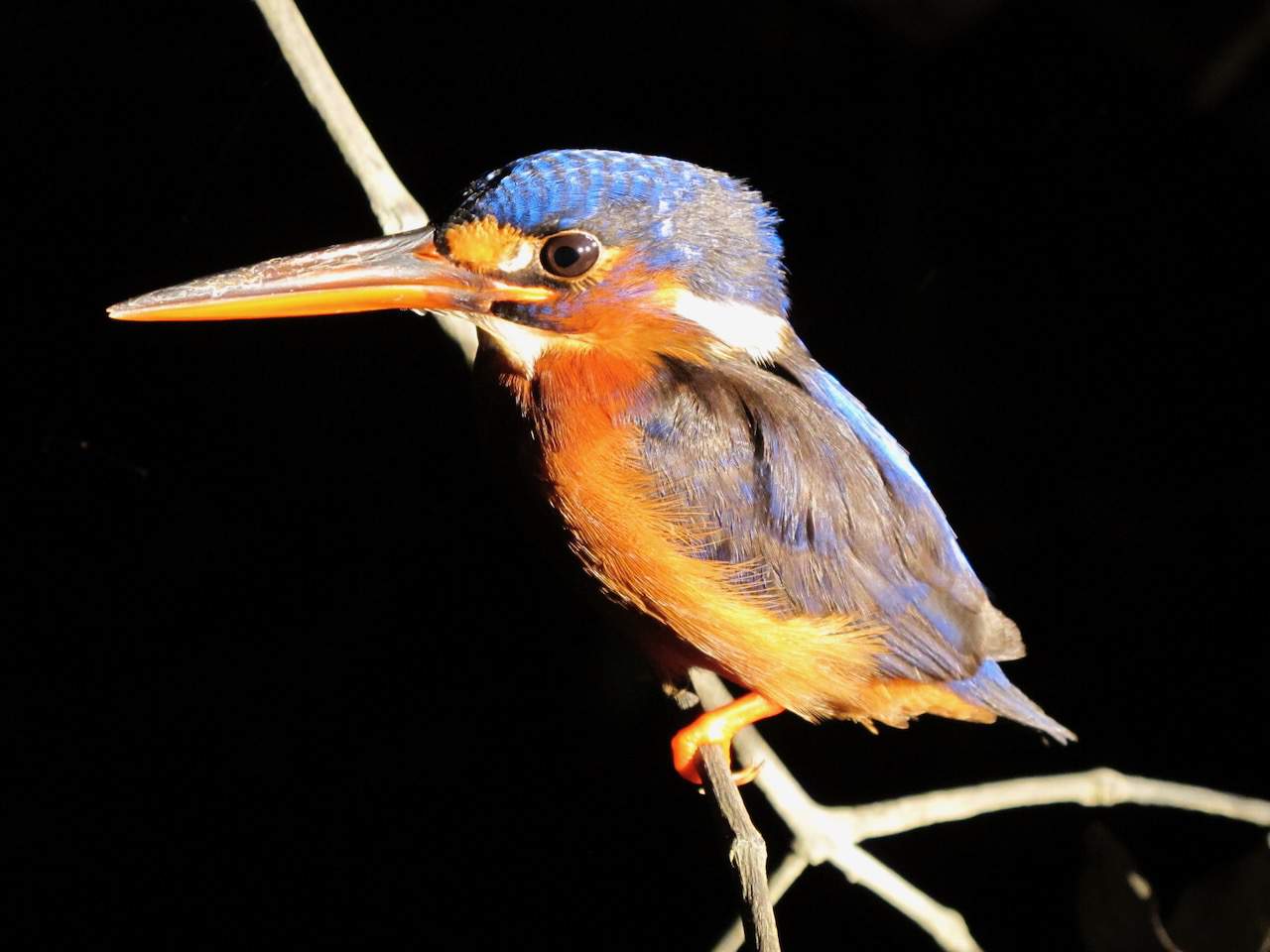
Sabah, one of two Malaysian states on the island of Borneo (map), is blessed with superb white sandy beaches, coral islands and large tracts of virgin tropical rainforests. Sabah is also the home of Mount Kinabalu, at 4,095 meters, the highest peak in Southeast Asia; unique and diverse wildlife such as the famous orang utans; and some of the most stunning diving sites in the world. There are many things to do in Sabah, especially for travellers who enjoy nature and food!
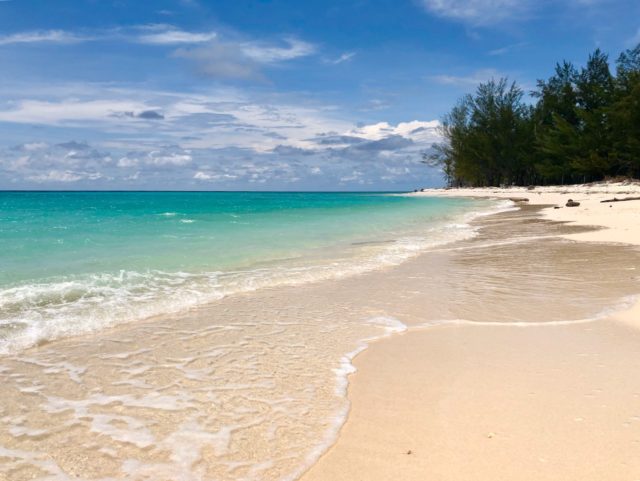 The glorious sands of Mantanani Island, north of Kota Kinabalu.
The glorious sands of Mantanani Island, north of Kota Kinabalu.

A paradise for nature lovers
Sabah is absolutely worth visiting, especially for nature lovers. The core of this state features a vast expanse of almost impenetrable tropical jungle that harbours an astonishingly rich variety of flora and fauna. Mighty rivers carve their way through the dense jungle while towering mountain ranges overlook the central and coastal plains. The remote reaches of this state are relatively unexplored and scientists are still finding new species of flora and fauna.
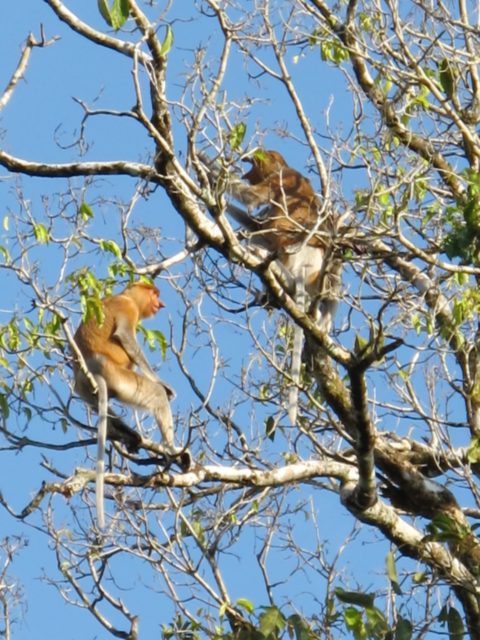 Spotting proboscis monkeys at the Kinabatangan River.
Spotting proboscis monkeys at the Kinabatangan River.
Sabah’s natural sights are truly overwhelming, from the oaks and conifers in the mountains, to lowland rainforest and mangrove swamps that hug the coast. In the numerous nature reserves, you’ll discover the smallest bear, the sun bear; the smallest elephant, the Bornean pygmy elephant; as well as many species of apes and birds. Among the most interesting national reserves are the Kinabalu Park, the Rafflesia Forest Reserve (a reserve dedicated to the world’s largest flower, the Rafflesia) – both near Kota Kinabalu; the Danum Valley; the Maliau Basin; and the Kinabatangan River, one of the top wildlife tours in Malaysia.
Kota Kinabalu
The capital of Sabah is Kota Kinabalu (often called ‘KK’), a bustling port city, and with its convenient international airport, functions as the gateway to the treasure chest of natural wonders that Sabah is world-renowned for. In addition, superb white sandy beaches and Mount Kinabalu are just a short boat-ride or drive away. The city has a modest number of sights to boast such as the State Mosque, the floating City Mosque, the Sabah Museum and the Waterfront.
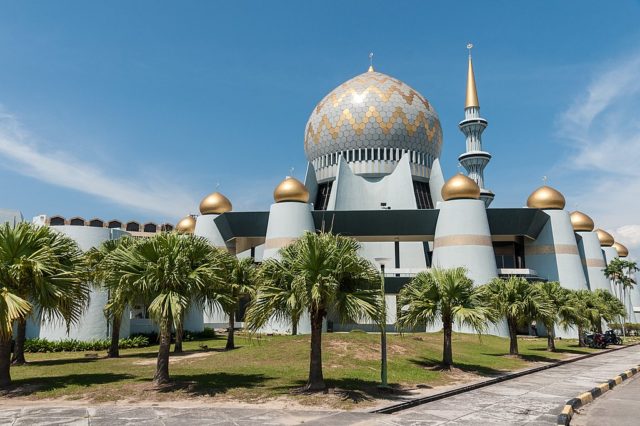 Sabah State Mosque in Kota Kinabalu (image by Wikimedia Commons).
Sabah State Mosque in Kota Kinabalu (image by Wikimedia Commons).
Located just outside the city, the Mari Mari Cultural Village is another interesting tourist attraction. The village is a showcase of the five tribes that inhabited the area. It’s a great place to learn more about Sabah’s diverse cultures.
Kota Kinabalu Waterfront
The Kota Kinabalu Waterfront, with its wide selection of Western and local restaurants and bars is a favourite hang-out for locals and tourists.
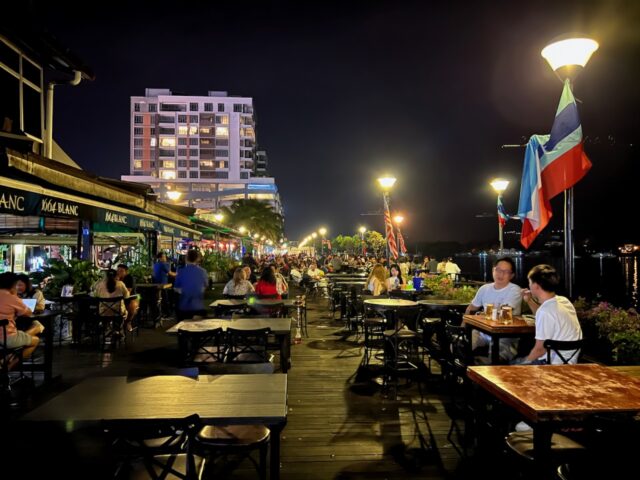 The Waterfront is a buzzing place in the evenings.
The Waterfront is a buzzing place in the evenings.
Kota Kinabalu markets
The city also has several markets, including the Souvenir Market and Night Food Market (also known as Anjung) at the waterfront opposite Le Meridien hotel, which are well worth a visit. I recommend sitting at one of the stalls of the Night Food Market for a delicious seafood meal. Visit the Central Market (Pasar Besar) to see the latest catch and fresh produce.
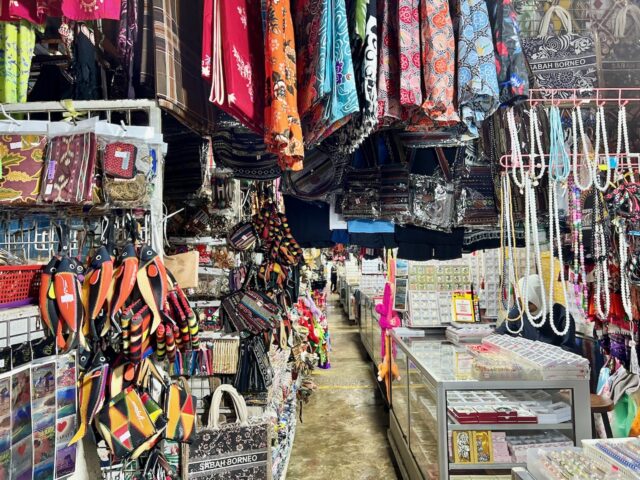 Shop for local handicraft and other souvenirs at the Souvenir Market.
Shop for local handicraft and other souvenirs at the Souvenir Market. 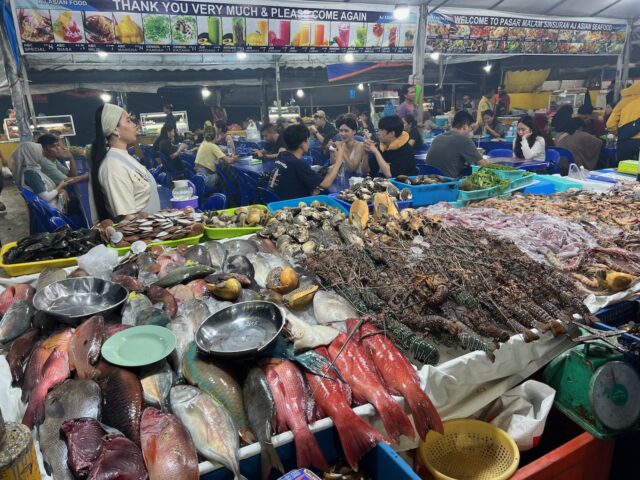 The Night Food Market is a fantastic multi-sensory experience!
The Night Food Market is a fantastic multi-sensory experience! 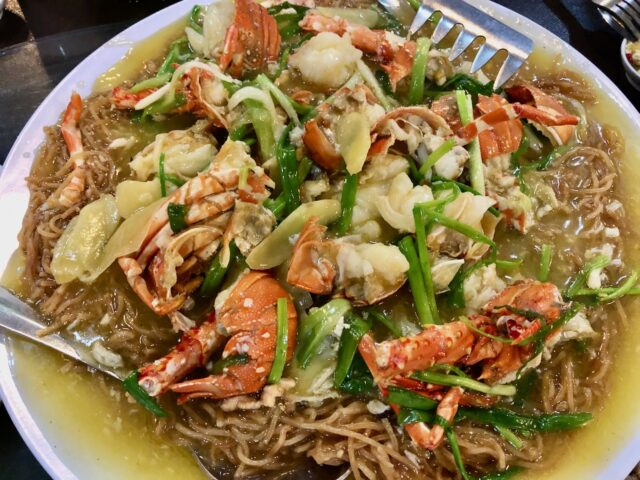 Yummy seafood noodles!
Yummy seafood noodles!  Fresh produce at the Night Market
Fresh produce at the Night Market
For a different market experience, plan a visit to a Tamu, a colourful Sunday market where the indigenous people sell cattle, agricultural produce and handicrafts. The Tamu can be found in Kota Belud or Tuaran, just north of Kota Kinabalu.
Seafood heaven
Kota Kinabalu (KK) vies with other Malaysian cities such as Kuala Lumpur and Penang for having the country’s best cuisine. Many visitors, in addition to using the city as a base for exploring the rest of the state, also come here to savour the fresh seafood (dozens of types of fish, clams, mussels, oysters, lobsters, crabs, prawns, etc…) that is prepared in many mouthwatering ways. Head to the Night Food Market in the evenings or check out restaurants such as Welcome Seafood at the AsiaCity Mall or Suang Tain Seafood and KK Garden Seafood at Sedco Complex.
 A delicious seafood meal
A delicious seafood meal
Tanjung Aru beach
Just a ten minute drive from the city centre is Tanjung Aru beach. The beachfront, lined with a modest variety of shops, restaurants and bars, is a favourite hangout among the locals and tourists who come here for a relaxing drink or meal, or to watch the sunset.
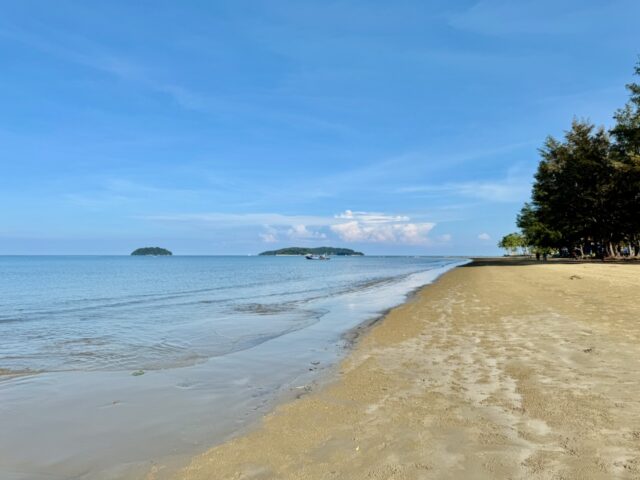 Tanjung Aru beach
Tanjung Aru beach 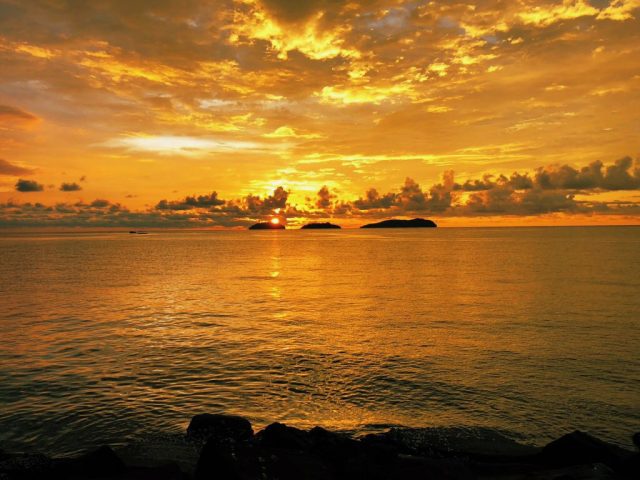 Sunset in Kota Kinabalu, Sabah, Malaysia.
Sunset in Kota Kinabalu, Sabah, Malaysia.
I can also recommend going on a paddle-boarding (stand-up paddling) trip from Tanjung Aru beach. Head North Paddle organises daily sunrise and sunset guided trips – I recommend the sunrise trip as it’s quieter and chances of seeing marine life and Mount Kinabalu are greater. During my trip, I saw some coral and lots of tropical fish (such as ‘Nemo’), starfish, stingrays and a turtle!
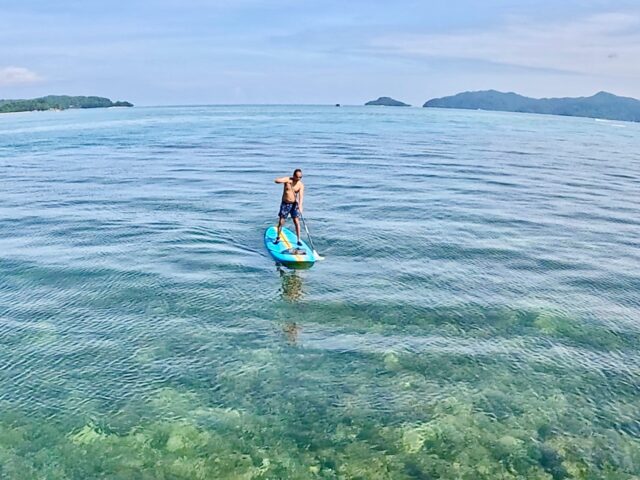 Me paddle-boarding off Tanjung Aru beach
Me paddle-boarding off Tanjung Aru beach
Where to stay in Kota Kinabalu
Hotels in Kota Kinabalu I can recommend include Le Meridien (city centre, opposite the waterfront), Hyatt Centric, Shangri-La Tanjung Aru, Pacific Sutera and Magellan Sutera. To the north of Kota Kinabalu lies my favourite beach resort in Sabah: Shangri-La Rasa Ria (it even has its own orang utan sanctuary!). Search for accommodations in Kota Kinabalu.
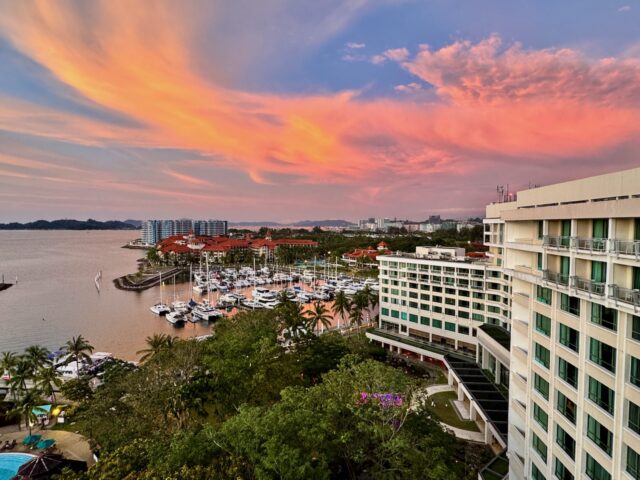 Sunset at Sutera Harbour (foreground: Pacific Sutera resort; background (red roofs): Magellan Sutera resort).
Sunset at Sutera Harbour (foreground: Pacific Sutera resort; background (red roofs): Magellan Sutera resort).
Tunku Abdul Rahman Marine Park
Off the coast of Kota Kinabalu lie five islands (Gaya, Manukan, Mamutik, Sapi and Sulug), which together form the Tunku Abdul Rahman Marine Park. These islands are popular amongst locals and tourists who come here to enjoy the crystal-clear water and pristine beaches. There are numerous coral reefs, which make the park a great snorkelling and diving destination. Boats for the islands leave from the Kota Kinabalu Jetty. There are several small hotels and resorts on the islands such as Sutera Sanctuary on Manukan Island, the luxurious Gaya Island Resort and Gayana Marine Resort.
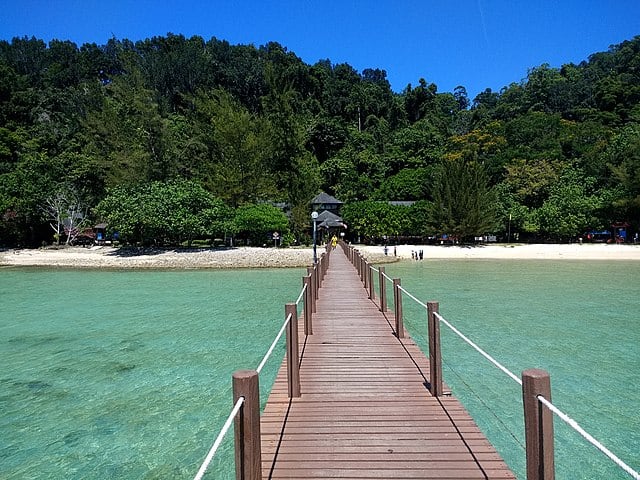 Gaya Island (image courtesy of Granger/Wikimedia Commons).
Gaya Island (image courtesy of Granger/Wikimedia Commons).
To the south of the city lies Ara Dinawan island, a picture-perfect island with thick jungles, pristine beaches and crystal-clear water. The island makes for a wonderful day trip from KK.
Kinabalu National Park
At the centre of this famous national park is Mount Kinabalu (map), at 4,095 meters, Southeast Asia’s highest peak, and a World Heritage site. The mountain rises majestically, towering over the surrounding plains and hills. The shape of the mountain changes continuously as you travel around it. The top of the mountain is crowned by a series of gigantic pinnacles and large granite humps. It is a fascinating mountain which the natives hold in veneration.
 Mount Kinabalu (image by NajuaR/Unsplash)
Mount Kinabalu (image by NajuaR/Unsplash)
The park itself is a treasure trove of plants and animals. With an estimated 5,000 – 6,000 plant species within its boundaries, the park has one of the richest biodiversities in the world. Look out for the insect-eating pitcher plants, and if you’re really lucky, you might stumble upon the world’s largest flower, the Rafflesia.
A leisurely trek up to the summit and down takes approximately two days and offers visitors a bewildering display of thousands of plant and animal species, some of which are endemic to the park. It’s also possible to enjoy the natural surroundings of Mt. Kinabalu on a day trip from KK.
See my pictures of Mount Kinabalu taken from the air. Search for accommodations around Mount Kinabalu.
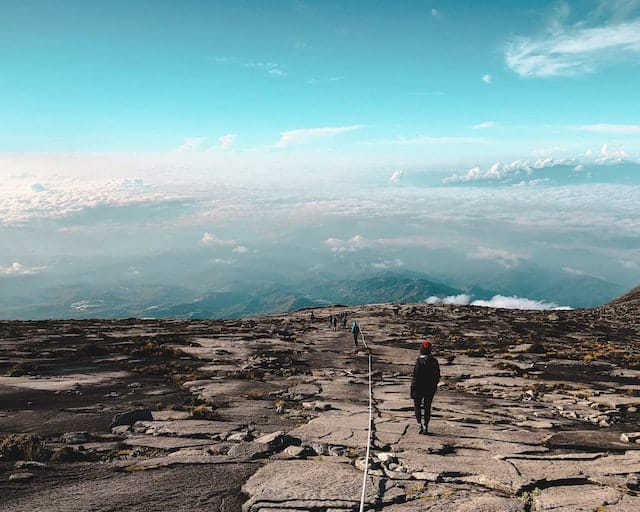 Climbing Mount Kinabalu (image by LingTang/Unsplash)
Climbing Mount Kinabalu (image by LingTang/Unsplash)
Sandakan
Sandakan (map) is Sabah’s second largest town and is the main gateway to various nature attractions. The town itself has a few attractions such as the Memorial Park (a WWII memorial at a site that used to be a Japanese PoW camp), the Agnes Keith House (the former residence of an American writer who lived in Sanadakan in the 1930’s), the Buli Sim Sim Water Village (a village built on stilts facing the Sulu Sea) and the Central Market. Search for hotels in Sandakan.
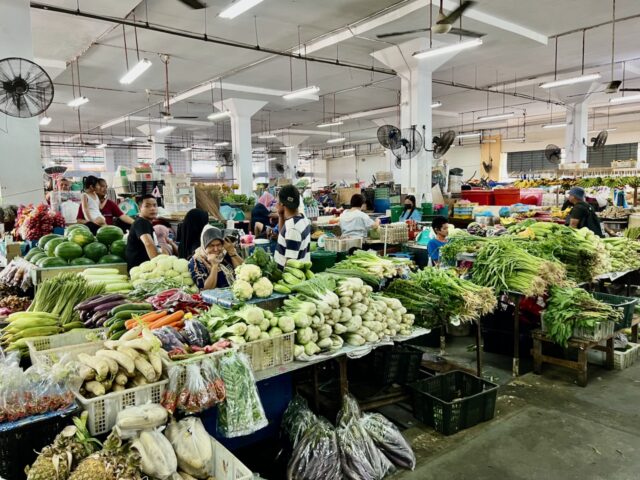 The Central Market
The Central Market  Sim Sim water village
Sim Sim water village
Many visitors use Sandakan as the gateway to places such as the Sepilok Orangutan Sanctuary, Selingan Turtle Island and Kinabatangan River.
Sepilok Orangutan Sanctuary
The world famous Sepilok Orangutan Sanctuary is located about 25 kilometers from Sandakan and is devoted to the conservation of the orangutan, a gentle ape that can only be found in Borneo and Sumatera. The sanctuary lies at the edges of the massive Kabili-Sepilok Forest Reserve.
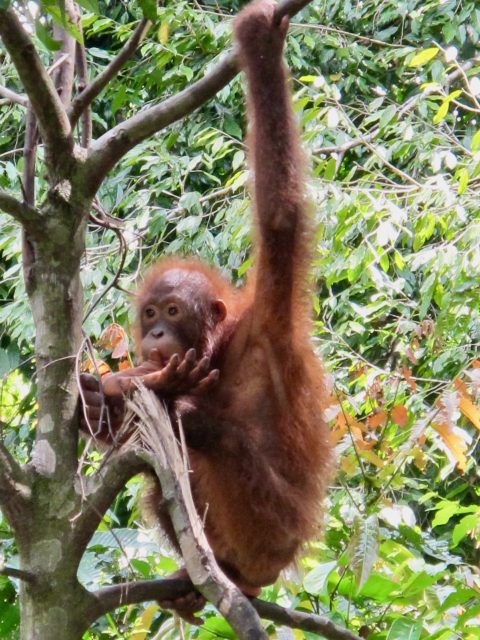 A juvenile orangutan at Sepilok
A juvenile orangutan at Sepilok
A visit to the sanctuary to watch the orang utans in their natural environment is a must for visitors to Sabah. Don’t forget to sign up to adopt an orang utan! Your contribution will go a long way in ensuring the survival of these endangered mammals. Read about my visit to the Sepilok Orang Utan Sanctuary.
Sun bear sanctuary
The sun bear sanctuary is situated across the road from the Sepilok Orangutan Sanctuary and does similar work to protect and rehabilitate the sun bear, the smallest of all bears.
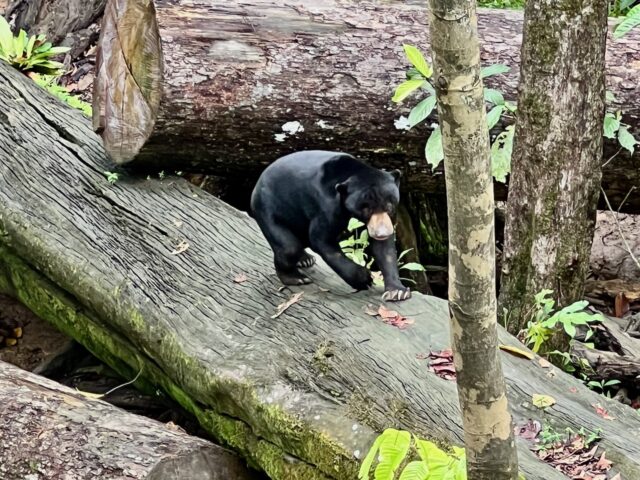 A sun bear at the sanctuary
A sun bear at the sanctuary
Rainforest Discovery Centre
Close to the Sepilok Orangutan Sanctuary lies another natural attraction, the Rainforest Discovery Centre. Here, visitors can learn all about the flora and fauna of the Borneo rainforests, go on a canopy walk and observe nature from the observation towers. Go in the early mornings or late afternoons when the animals are most active. You might spot a variety of wildlife such as orangutans, hornbills and flying squirrels!
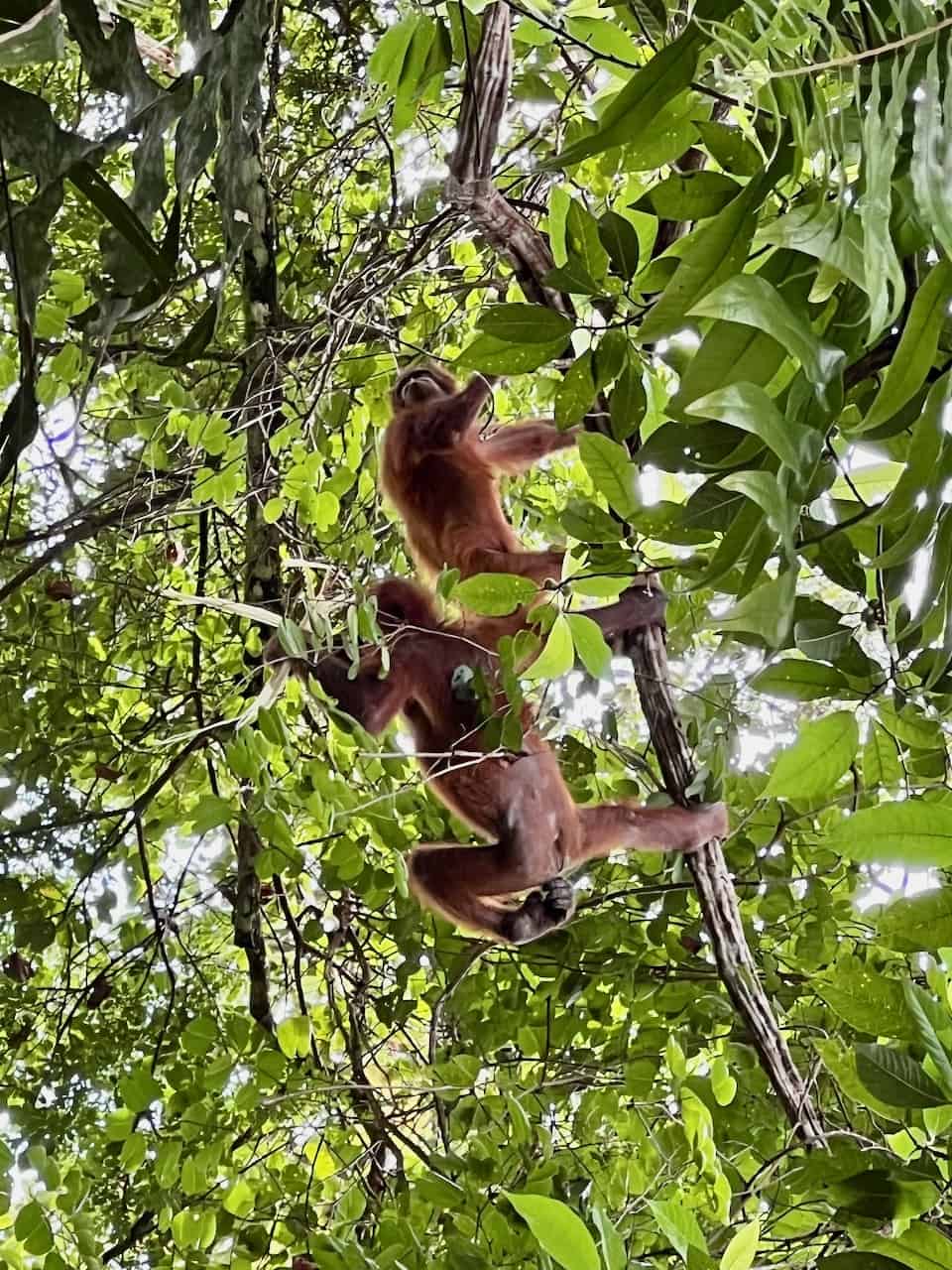 Orangutans at the Rainforest Discovery Centre
Orangutans at the Rainforest Discovery Centre 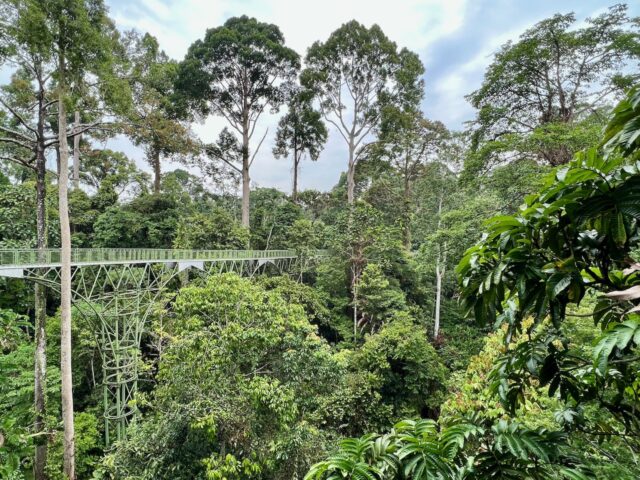 The canopy walk
The canopy walk 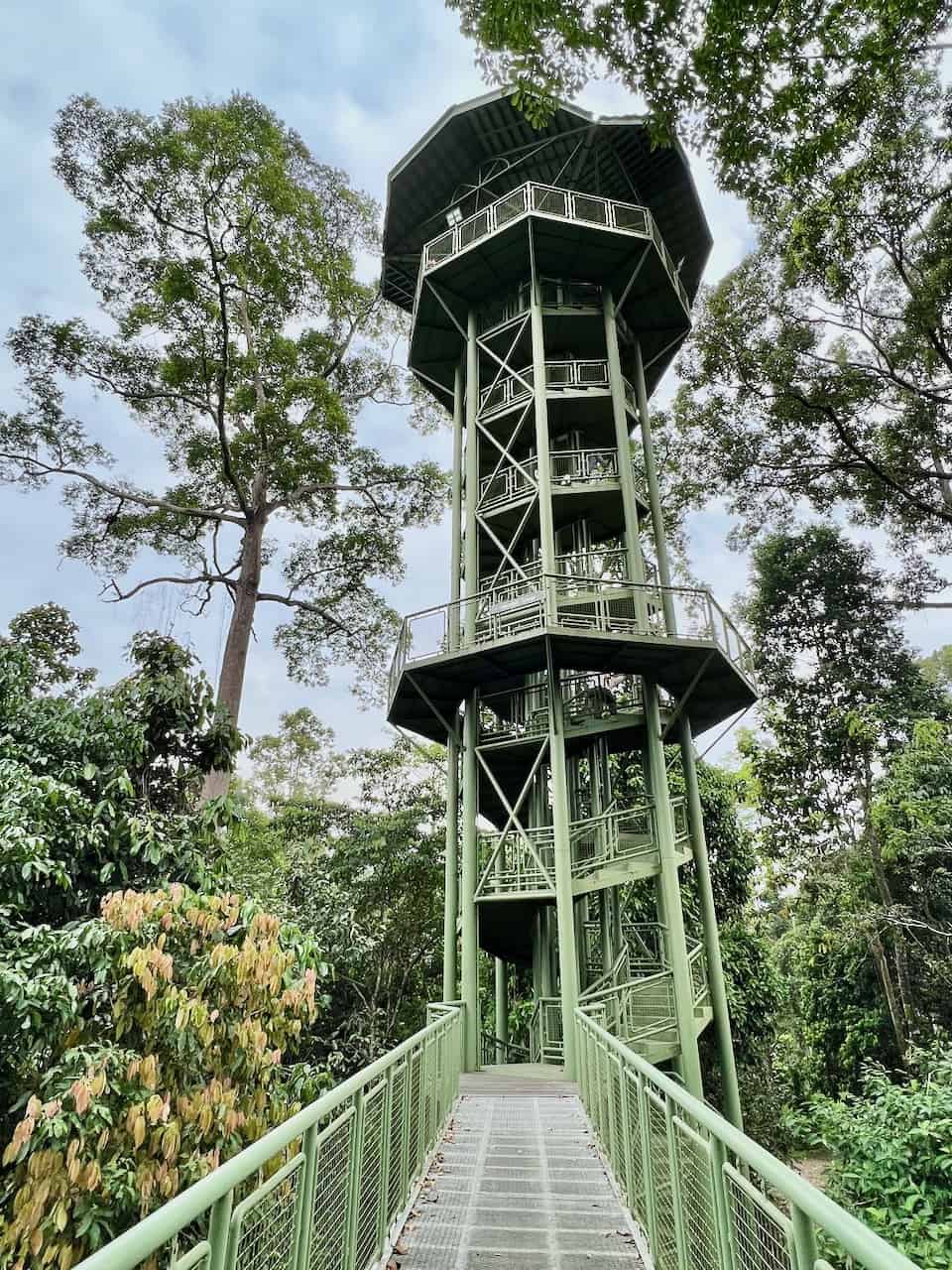 One of the nature observation towers
One of the nature observation towers
Accommodations in Sepilok
There are various accommodations in the Sepilok area. I recommend staying in this area for 1-2 nights to enjoy the various parks at a leisurely pace. One accommodation I recommend is the Sepilok Nature Resort. This resort, tucked away at the edge of the rainforest, is a true paradise! The chalets are very comfortable and each have a deck from which you can see and listen to the forest.
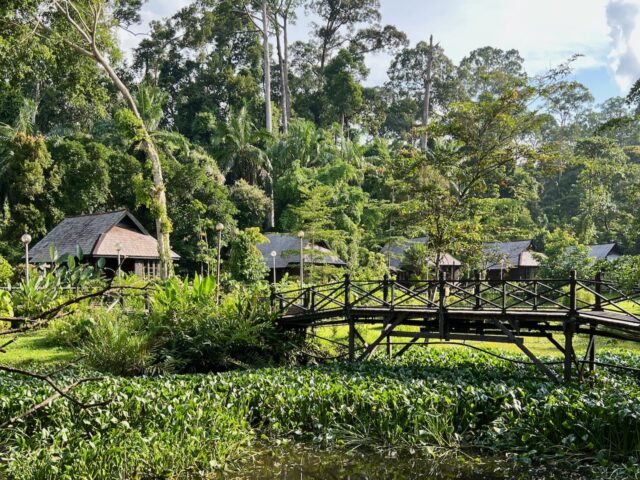 Sepilok Nature Resort chalets
Sepilok Nature Resort chalets
Gomantong Caves
The Gomantong Caves (map) are enormous limestone caves located about a two-hour drive from Sandakan. What makes these caves unique are the edible birds’ nests which are built high in the crevices of the cave’s ceiling, more than 30 meters above the cave floor. The nests have been harvested for centuries by the locals and sold to the Chinese who consider it a delicacy. The caves themselves are a majestic sight. The main chamber is huge and reaches a height of about 40 meters. One corner of the chamber resembles a massive pipe organ, giving credence to the cave’s cathedral-like feel.
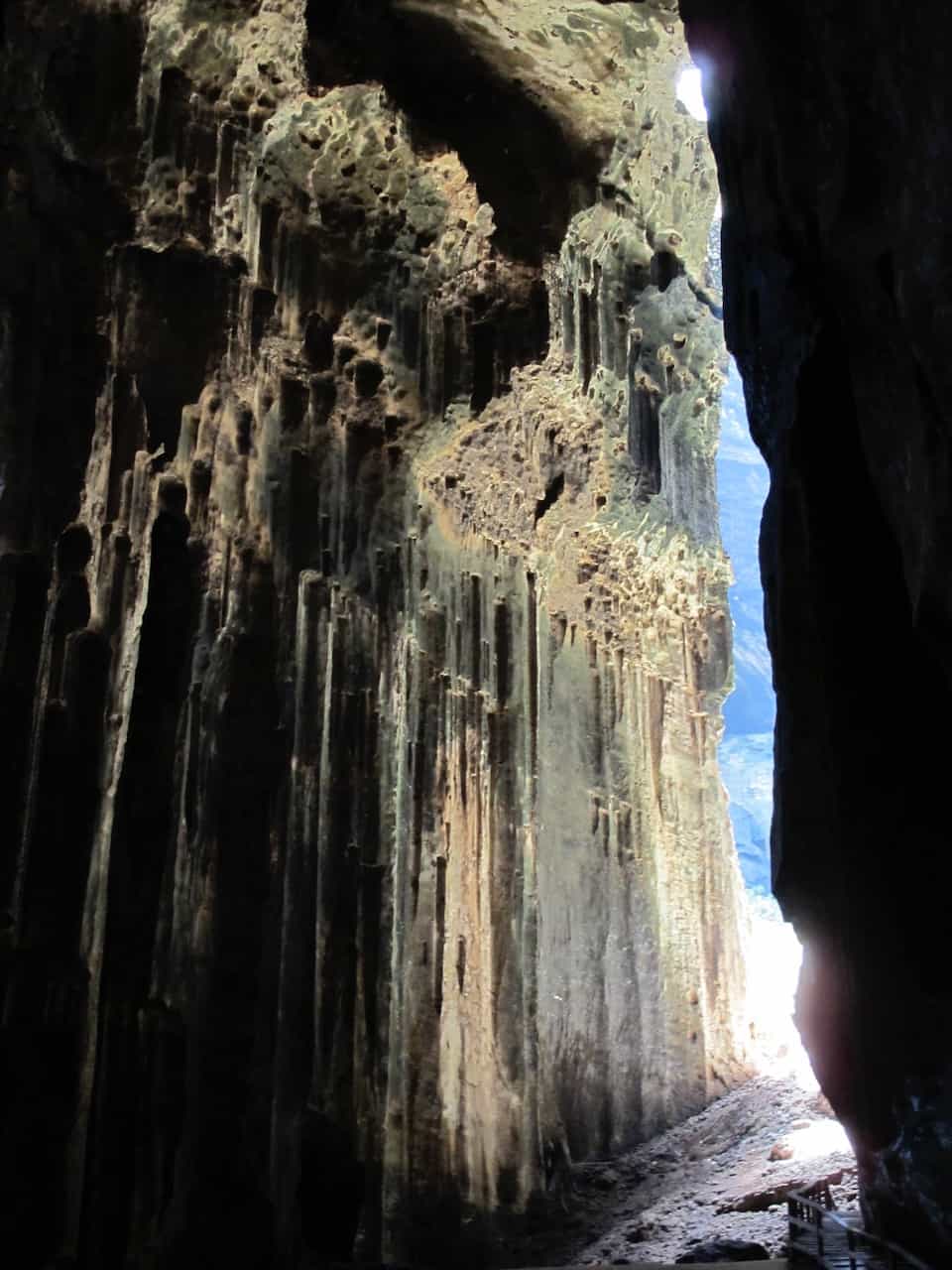 Gomantong cave
Gomantong cave
Kinabatangan River
The longest river in Sabah is home to an amazing variety of flora and fauna. Nowhere else in Sabah will you be able to spot the Borneo Big Five: orangutan, crocodile, Proboscis monkey, pygmy elephant and the rhinoceros hornbill, but along the shores of the Kinabatangan River.
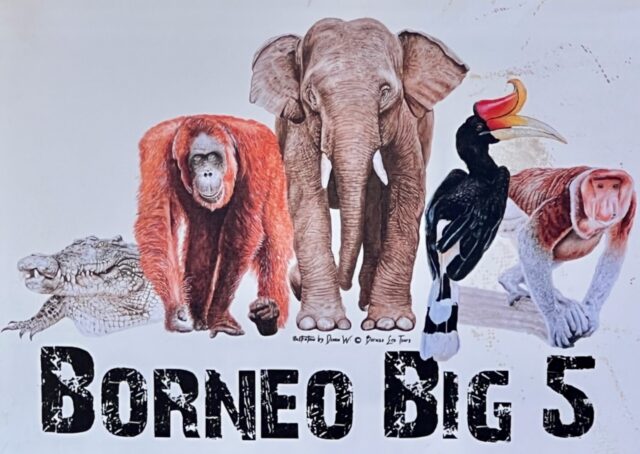 The Borneo Big Five
The Borneo Big Five 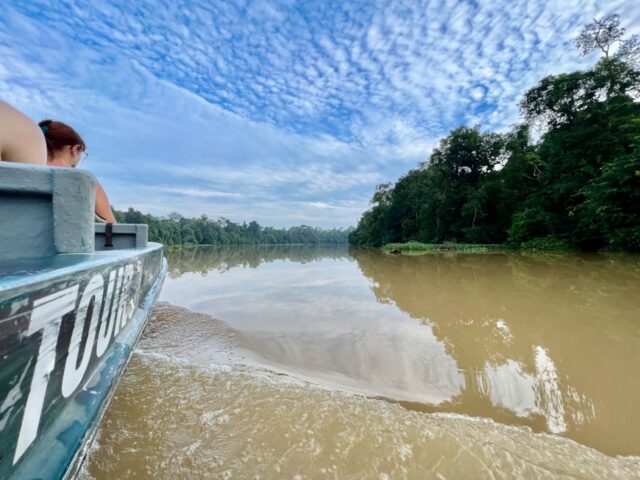 Go on a morning river safari
Go on a morning river safari 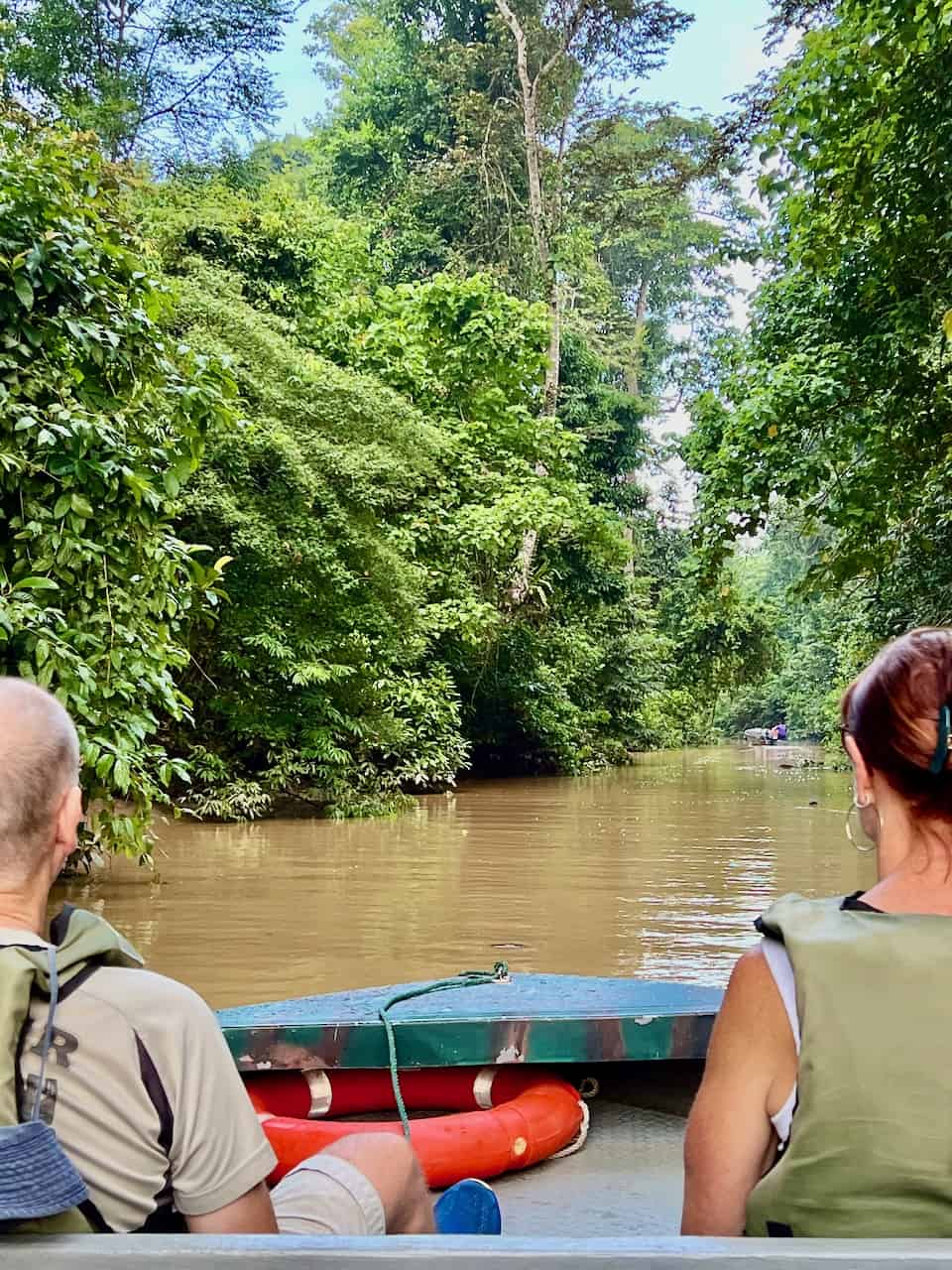 During a safari, you’ll spot a variety of wildlife along the riverbanks.
During a safari, you’ll spot a variety of wildlife along the riverbanks. 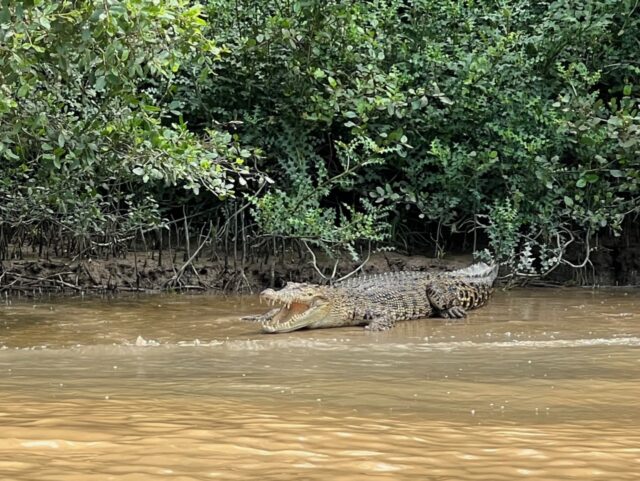 A crocodile, one of the Borneo Big Five
A crocodile, one of the Borneo Big Five 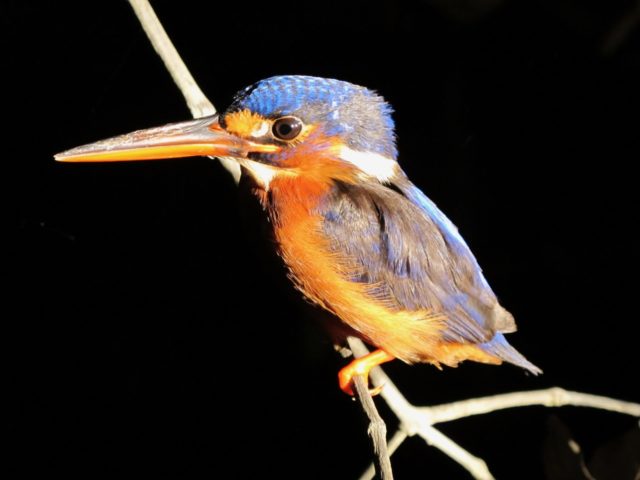 A kingfisher spotted during a night safari along the Kinabatangan River.
A kingfisher spotted during a night safari along the Kinabatangan River.
I recommend spending a few days at one of the riverside lodges (near the village of Sukau) to truly appreciate the majestic nature. Go on several river safaris in the mornings, late-afternoons and evenings to see the different animals. Read about my Kinabatangan River Safari.
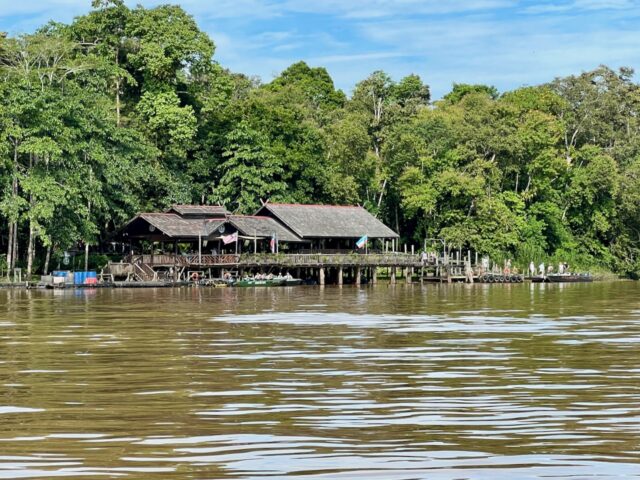 One lodge I recommend is the Sukau Rainforest Lodge
One lodge I recommend is the Sukau Rainforest Lodge
Sabah’s islands
Sabah’s coast boasts some of the most pristine islands in Malaysia. Put on your snorkel or diving gear and explore the rich and varied underwater world. Some of the world’s best diving sites are found off the islands of Sipadan, Mabul and Layang Layang.
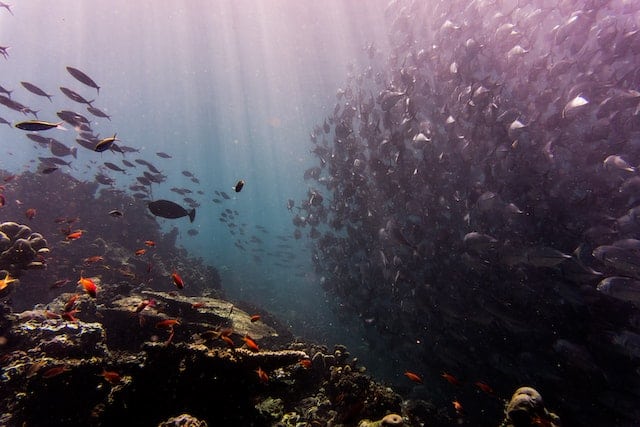 Schools of fish in the waters off Sipadan Island (image by JChen/Unsplash).
Schools of fish in the waters off Sipadan Island (image by JChen/Unsplash).
Sipadan is Malaysia’s only oceanic island. Just off the beach, a spectacular coral wall drops 600 meters down to the sea floor. Explore the rich diversity of multi-coloured soft and hard corals and experience swimming among manta rays, huge parrotfish, barracudas, a variety of sharks including hammerheads and a host of other brightly coloured tropical fish. Sipadan was made famous the world over by renowned explorer Jacques Cousteau.
 Layang Layang
Layang Layang
For a close encounter with Green and Hawksbill turtles, head for the Turtle Islands Park. One of the best places to spot whale sharks, the planet’s largest fish, is Lankayan island, located in the northeastern corner of Sabah, in the Sulu Sea. Sightings of the whale shark are very regular during the months of April and May. Mantanani island, just north of Kota Kinabalu also offers excellent snorkel and diving opportunities. Check out the Sutera Mantanani Resort.
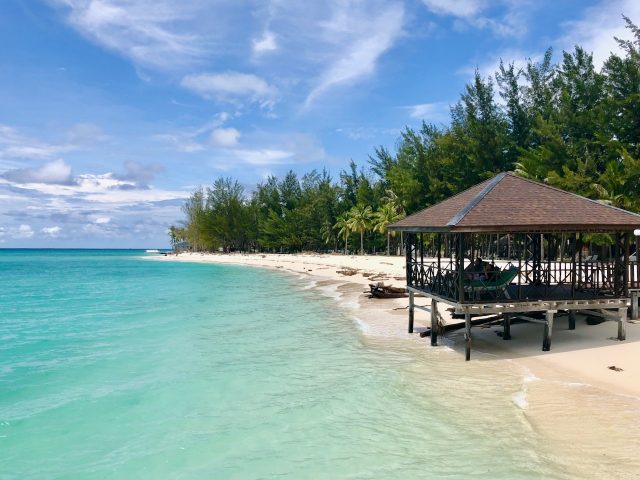 Mantanani island
Mantanani island
Booking.com
Danum Valley
The serious nature lover will be awed by the vast array of plant- and animal life in the Danum Valley. All of Sabah’s mammals and most of its birds (including eight species of hornbills) can be found here.
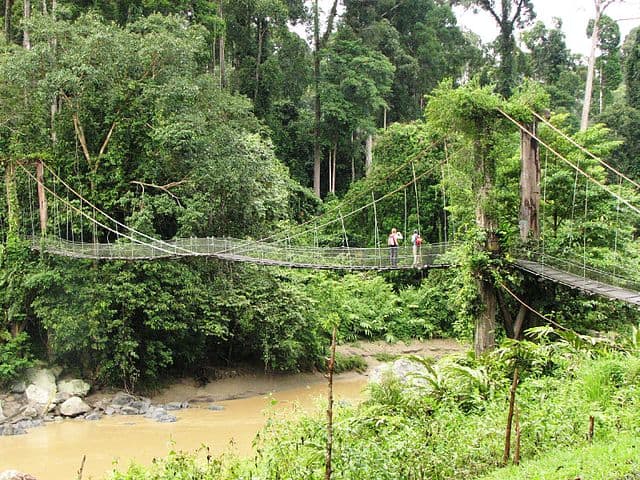 Danum Valley (image courtesy of Levy/Wikimedia Commons)
Danum Valley (image courtesy of Levy/Wikimedia Commons)
Maliau Basin
For the adventurous, head for the Maliau Basin, a large area completely surrounded by a high limestone escarpment (rather like a caldera). When this area was first explored in the 1990’s, it was termed the ‘Lost World’ as the impenetrable rainforest made it virtually impossible for humans to inhabit this area. As a consequence, many new plant and animal species have been found here. A conservation and management programme has been started, aided by both local and foreign scientists. The basin is also famous for its magnificent seven-tier Maliau Falls.
How to get to Sabah
Kota Kinabalu is the main gateway to Sabah. Its modern airport (BKI) has frequent flights to many regional hubs such as Kuala Lumpur, Singapore, Hong Kong, Seoul and Tokyo. From Kota Kinabalu, there are connections with other towns such as Sandakan, Tawau and Lahad Datu. You can also fly to Sandakan from Kuala Lumpur.
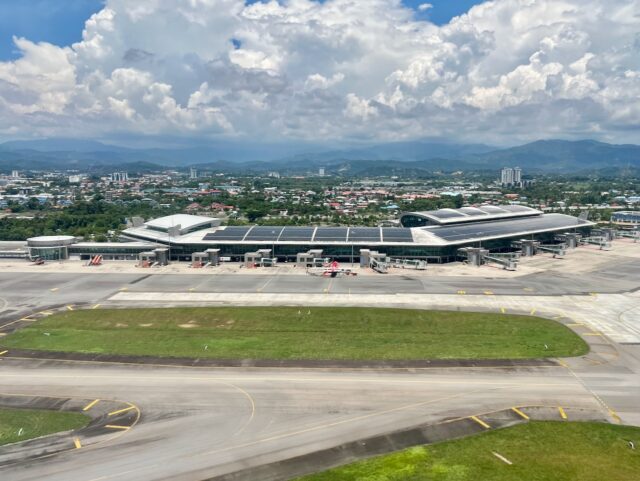 Kota Kinabalu International Airport
Kota Kinabalu International Airport
Read more about Malaysia on Velvet Escape:
Please visit:
Our Sponsor
